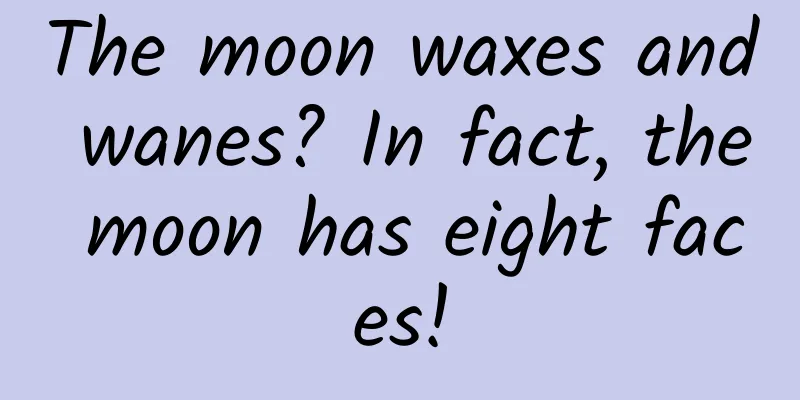The moon waxes and wanes? In fact, the moon has eight faces!

|
Do you know what shape the moon is? Round? Half round? Crescent? Studying the unchanging phases of the moon In 1610, Italian scientist Galileo used a homemade telescope to observe the moon for the first time. Although he did not see the Jade Rabbit or Chang'e, he saw the shape of the moon. The original shape of the moon is round. Why is the moon round, but the shapes we see with our naked eyes are in various shapes? Why is it that the only part of the moon we can see with our naked eyes on Earth is the part illuminated by the sun? “People have joys and sorrows, separations and reunions; the moon waxes and wanes.” The waxing and waning here refers to the changes in the phases of the moon. The moon itself does not emit light. Its light mainly comes from the sun. Therefore, when the moon revolves to different positions, the illuminated areas we see on Earth are also different. The cycle of the moon phase is about 30 days, or 29.53 days to be exact. Replicating the moon phases Let's prepare a large black cardboard, the bigger the better, a round mold, 8 balls, a larger ball, yellow paint, black paint, a carving brush, and any sticky things that can fix the balls on the cardboard. The big ball painted yellow is the sun, the small ball painted black is the moon, the sun is fixed here, the moon revolves around the earth to various positions. The places that can be illuminated by the sun are white, which is the part we can see with our naked eyes on the earth, and the black ones are without sunlight, and the parts we can't see will be completed. Now I am standing on the earth to watch the eight forms of the moon phase change, and the sunlight is shining from here. Name the moon phases! When the moon is between the earth and the sun, the dark side of the moon faces the earth, and we cannot see the moon at all. This is the new moon, also called the crescent moon. As the moon continues to revolve eastward, the part of the moon we can see gradually becomes larger. When the sun, earth and moon are at right angles, we can see a semicircular moon, which is called the waxing moon. The moon continues to orbit, and when the sun, earth and moon are in a straight line again, with the earth in the middle, we can see a full moon, which is the waxing moon. After the full moon, the bright part of the moon gradually becomes smaller, and the sun, earth and moon become at right angles again, and the full moon becomes half, which is called the waning moon. The new moon is the beginning of a month, which is the first day of the lunar calendar. The full moon is the fifteenth day of the lunar calendar. The remaining time can be calculated by dividing it by 2. The time of the first quarter moon is the seventh or eighth day of the lunar calendar, and the time of the last quarter moon is around the twenty-third day of the lunar calendar. In addition to these four moon phases, the two crescent moons are the crescent moon and the colorful moon, and the two bulging moons are called the waxing gibbous moon and the waning gibbous moon. The above moon phases are what we see in the northern hemisphere. If we go to the southern hemisphere, it will be symmetrical. The article is produced by Science Popularization China-Creation Cultivation Program. Please indicate the source when reprinting. Author: "Look! My Discovery" Beijing Yami Culture Media Co., Ltd. Science Creation Team Reviewer: Zhou Xiaoliang, Senior Engineer, Physics Laboratory, Beijing Jiaotong University |
<<: It only takes a few minutes a day to lower blood pressure and reduce the risk of heart disease!
Recommend
Changing managers has become a habit in the United States. No one can last more than five years and the next one will have a hard time.
According to a recent comprehensive foreign news ...
What is the market price for a bottle of 52-degree platinum cellar-aged wine (Kweichow Moutai Distillery)?
How much is the market price of a bottle of 52-de...
How can I make my WeChat mini program rank higher in search engines?
After Jump Jump became popular, more people paid ...
How to solve the problem of self-driving cars being frequently forced to stop by experienced drivers
We only know that autonomous driving has become a...
Today is Minor Cold丨Be a snow-walking wild goose, be a snow-covered pine
"There are plum blossom trees at the foot of...
Do you want to be on the trending list? Read this before deciding
If a product with good ASO is like a famous celeb...
Tesla releases new national standard charging adapter, you can charge your car anywhere
Recently at the Guangzhou Auto Show, Tesla releas...
Brother Han teaches you how to use iOS - Experience sharing
[[148033]] This article mainly explains 4 questio...
Do you have the same stutter as Shen Gongbao? The doctor teaches you how to speak smoothly from "stuttering"
The domestic animated film "Nezha: The Devil...
Is postpartum depression just pretentious?
This is the 4672nd article of Da Yi Xiao Hu After...
Tips for cold-starting short video community content!
The short video community is dominated by content...
Customer acquisition and conversion methods: applicable to both e-commerce and knowledge payment
Recently many friends have asked me why other peo...
Behind Li Jiaqi’s sudden popularity: Is KOC in fashion?
As the Internet traffic dividend disappears, prod...
Baidu screen domination quick ranking detailed practical experience, keyword interception screen domination, achieve explosive drainage, even novices can get started
2021 Baidu screen domination fast ranking detaile...
How to build a refined user operation system for the community?
Community operation is actually user operation , ...









